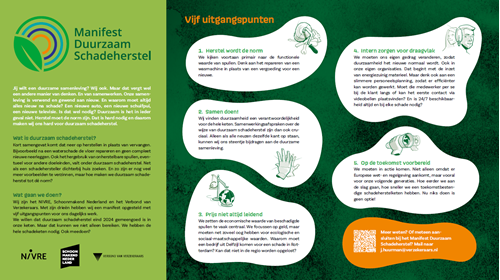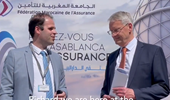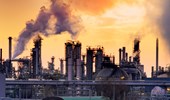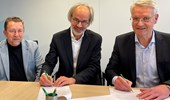In a sustainable world, people, the environment and the economy (people, planet, profit) are in balance. Major topics in the field of sustainability for insurers at the moment are responsible investment policy, reducing CO2 emissions and a safe energy transition.
Sustainable Damage Repair Manifesto
Sustainable repair must become the norm when dealing with claims, rather than replacing them. To this end, Schoonmakend Nederland, the NIVRE (Dutch Institute of Registered Experts Foundation) and the Dutch Association of Insurers have drawn up a manifesto with principles for future damage repair. And want sustainable damage repair to be commonplace in the non-life market by the end of 2024. The Sustainable Damage Repair Manifesto was signed during the Claims Afternoon 2023, which the Dutch Association of Insurers organises annually.
Want to know more about the ambitions of the Manifesto?
Click on the image to open the manifest:
Responsible investment policy
The members of the Association represent an invested capital of more than 400 billion euros. Through the IRBC agreement , the insurance sector is working to further improve its entire responsible investment policy. This presents challenges, such as encouraging companies to reduce CO2, obtaining data on CO2 emissions, active ownership and exclusion policies, and setting their own reduction targets. Every insurer tries to do its bit, and of course more is expected of large investors.
Reducing CO2 emissions
It is a huge task to reduce harmful CO2 emissions in accordance with the Paris Agreement. The Dutch insurance sector contributes to this, among other things through its commitment to the Climate Agreement. Most institutions have mapped out the CO2 footprint of their investments. In 2022, insurers started concrete action plans to reduce the CO2 impact of their investments in order to boost the Dutch climate agreement.
Guide to net zero transition
Non-life insurers can use the 'Guideline net zero transition' to draw up a concrete net zero strategy for their claims portfolio. The guide contains concrete tools to reduce CO2 emissions to net-zero through sustainability targets and a transition path to follow.
Do you have any questions about the guide? Feel free to ask Timo Brinkman, Programme Coordinator for Sustainable Damage Insurance at the Dutch Association via t.brinkman@verzekeraars.nl
Safe energy transition
The switch to sustainable, inexhaustible energy sources helps to combat CO2 emissions and climate change. It has therefore been agreed in the Climate Agreement that the share of renewable electricity must be seventy percent by 2030. The Dutch government is therefore fully committed to the use of sustainable forms of energy, from solar panels to hydrogen. Homeowners, businesses and governments are being urged to switch to renewable energy through legislation, regulations and incentives. Every private individual and entrepreneur has to deal with it, and so do insurers. In addition to sustainability, this rapid transition also poses risks. The Association is therefore committed to a safe energy transition.





